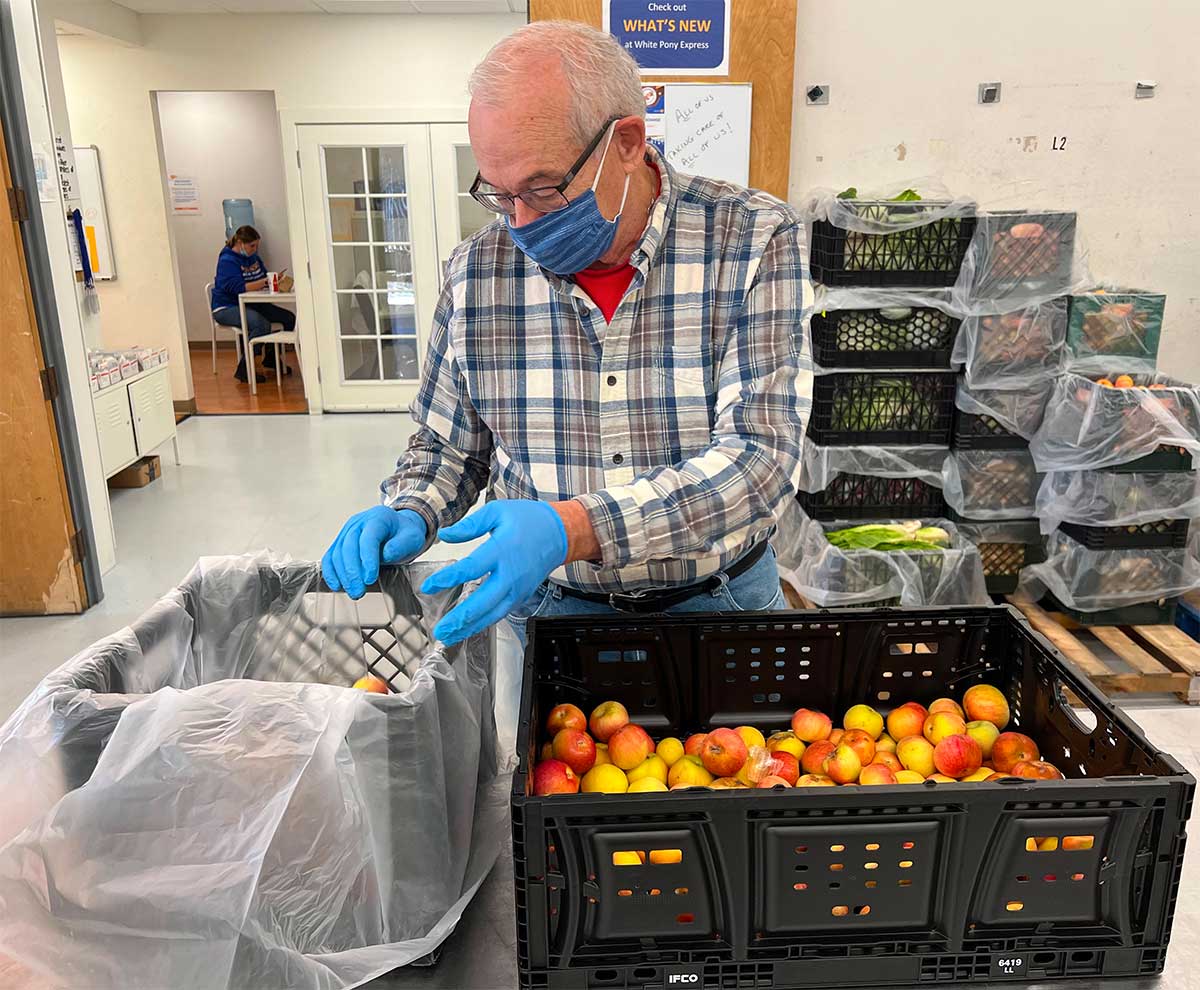SECOND HARVEST OF Silicon Valley has experienced one of the busiest years in its 48-year history this year, due to the state’s first food waste law and the ongoing hunger crisis since the pandemic.
On a recent day, 52 volunteers worked the morning shift in Second Harvest’s warehouse located at 4001 N. First St. in San Jose, sorting through potatoes, carrots, lettuce and many other fresh foods donated daily from grocery stores, farmers’ markets and restaurants. Carefully, the volunteers inspected the cargo, removing items no longer edible, such as onions with broken skin and apples with mold.
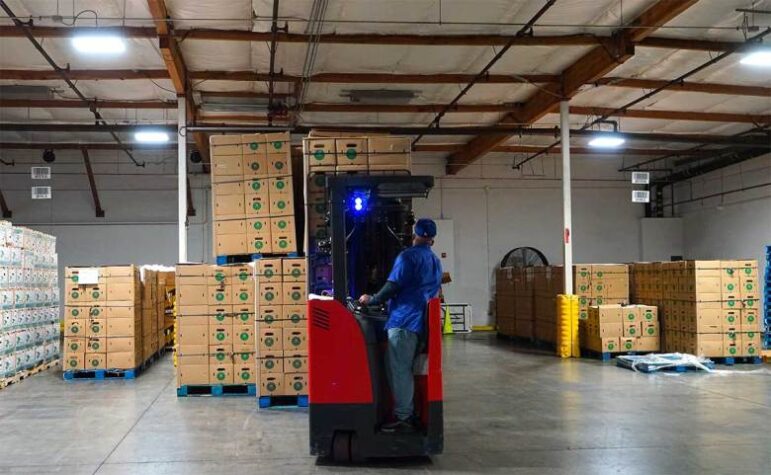
This food sorting process occurs in food banks, smaller food pantries and other food rescue organizations in the Bay Area every day. Organizations like Second Harvest serve as a vital link between businesses with surplus food and hungry people in need.
However, food bank officials say the new state law, which was filed as Senate Bill 1383, has created unintended challenges that weigh down their ability to divert and distribute food to needy folks.
Signed into law in 2016, SB 1383 went into effect on Jan. 1 of this year with aims to achieve a 75 percent reduction in organic waste in landfills by 2025, as well as a 20 percent diversion of edible food. It requires grocery stores, restaurants and other food suppliers to sign an agreement with a food rescue organization and donate their maximum amount of surplus food.
While food banks recognize the intent of the law to address food waste, some of them raise concerns about the challenges the law brings. The organizations are grappling with issues ranging from inadequate storage and greater need to procure trucks and volunteers to timely redistribution of larger loads of donations and problems with receiving expired and rotten food.
“This kind of food rescue has always been a part of what food banks do since their founding,” said Tracy Weatherby, Second Harvest’s vice president of strategy and advocacy.
“We are excited about the opportunity to get even more variety into the hands of our community,” she said. “But it does require a lot of coordination and logistics and funding to ensure that we can create that infrastructure.”
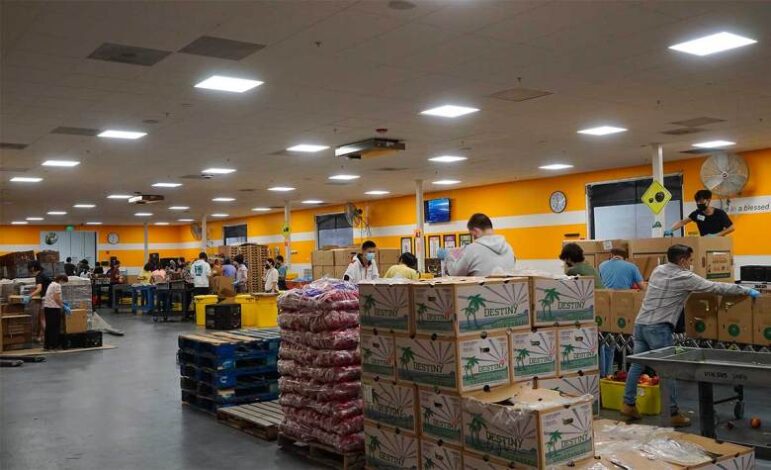
Bay City News talked to four food rescue organizations, three county officials and other relevant businesses to look at the challenges and how organizations collaborate with counties and other local jurisdictions to create new strategies and help make the law work.
Implementing SB 1383 is an opportunity to both reduce hunger and prevent food from turning into methane and other greenhouse gases in landfills, said Andrew Cheyne, director of government affairs at the California Association of Food Banks, a statewide anti-hunger organization.
However, recovering food includes complex logistics and expenses that require rapid pickups and distribution to keep the food fresh. It can be especially challenging for food banks when lacking storage and staffing and facing other capacity issues.
Prompted by the law, many more businesses have reached out to Second Harvest and expressed their willingness to donate this year, Weatherby said.
The law divides food suppliers into two tiers. Tier One includes grocery stores and supermarkets that typically have more produce and shelf-stable food to donate, and Tier Two businesses are hotels and restaurants with more prepared food. Tier One businesses must comply this year; Tier Two has two years to prepare.
Weatherby said that her organization prioritized Tier One businesses to work with since they needed to have agreements in place this year, per the new law.
Second Harvest now has 36 tractor trailers that run all the time during the day to pick up large donations from grocery stories daily. The organization still plans to expand its storage, volunteer work and add a new coordinator as the pressure on rapid food delivery grows.
About 50 percent of the food is fresh produce, Weatherby said, which needs to be inspected and then given out within the same day or two.
As businesses are often inclined to hold onto the products as long as they can get, those being donated are often outwardly imperfect or show signs of decay.
“The reason we’re getting these donations is because things are closer to the end of their life,” Weatherby said. “So we need to make sure that we have the operations and logistics to turn that food around very quickly and get it to the people who need it.”
Before this year, major national retailers such as Walmart, Target, Costco and Safeway already started donating surplus food voluntarily, but now all local grocery stores are required by the law to participate.
Second Harvest in Silicon Valley recovered 17 million pounds of food from January to June this year, enough for about 14 million meals serving hungry people in Santa Clara and San Mateo counties. The amount is about the same as last year, but it largely increased from previous years before the pandemic and will continue to grow as more donors come in.
Like other large food banks, Second Harvest contracts with a network of donors and recipients and operates as a central hub. The organization not only diverts and distributes food itself, but also enables its 79 partner agencies to pick up food from suppliers independently. The agencies include Santa Clara County Library District, Santa Clara County Food System Alliance and nonprofit organizations such as Boys & Girls Clubs of the Peninsula.
“The scale of the work that we do is extremely large and I think people often don’t realize that,” Weatherby said.

A potential solution to solve capacity and distribution issues, food bank organizers said, is to foster more direct partnerships between donors and partner agencies.
For instance, Second Harvest contracted with several Asian grocery stories this year. Weatherby helped partner them up with agencies that serve a large Asian population to ensure “the food goes to where it will be most valued.” In such partnerships, agencies can often pick up the food and deliver cooked meals without food banks being a transfer station.
To solve similar issues and encourage donations, White Pony Express, a food recovery organization in Pleasant Hill serving Contra Costa County, has created an app-based food distribution system to connect businesses directly with local communities.
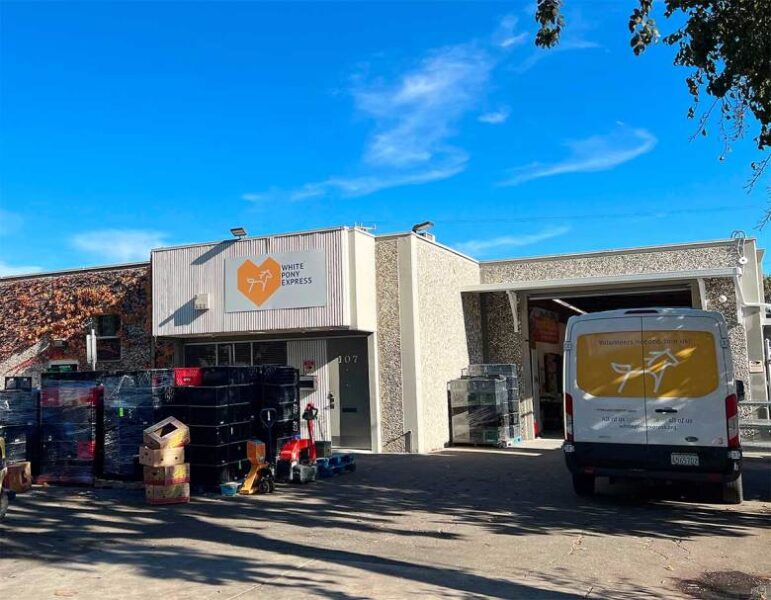
In February, White Pony Express established a new food donation model in partnership with RecycleSmart, which provides solid waste services for central Contra Costa County residents and businesses. The model creates a new food collection and distribution system through an application called White Pony Express, mainly targeting smaller potential donors within the county, including hotels, restaurants and health facilities.
The app is volunteer-based. Once signed up, a business can signal when it has excess food, and an available volunteer will pick up and deliver it directly to a matching food recipient organization.
Pete Olsen, the food sourcing manager at White Pony Express, said that about 200 volunteers have signed up as of June, but he is still working on engaging businesses to participate.
“We’re positioning ourselves as a solution and like an ally,” Olsen said.
Currently, the volunteers are still helping divert food from the organization’s warehouse to people and communities in need. Olsen hopes the app can be in full operation with more businesses joining the program in the future.
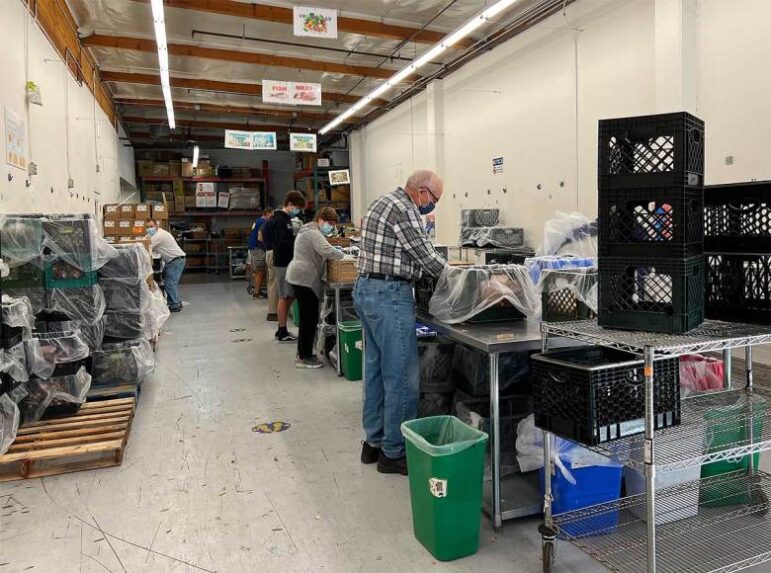
Another pressing issue is food banks are having to devise ways to maintain quality as more donated food comes in. If the food comes in fresh, it may be able to stay at food banks longer, and if the food is properly labeled and packaged, it will save food banks lots of work in determining if it is still useful.
However, SB 1383 only requires businesses to donate their surplus food; it doesn’t set a standard of what food is considered donatable and edible, organizations said.
“We don’t want to be hauling people’s trash,” Olsen said. “And the problem comes in that everyone’s got their own interpretation of what makes good food and what is edible food.”
It’s part of food banks’ traditional job to teach donors about their food safety standards, but businesses may not always listen. Olsen said his organization tries to keep rotten food received under 10 to 20 percent. He communicates a lot with donors about standards and food handling techniques and occasionally has to terminate partnerships with donors if their food is not edible and healthy.
Another food bank in Contra Costa encountered the same issue. Karen Collins, food resource manager of Food Bank of Contra Costa and Solano, said her organization was concerned about the uncertainty of future food volume and more food quality issues it may bring.
“As we got further into the year, the [food waste] generators are definitely reaching out more and getting more in tune with realizing they have responsibilities to SB 1383,” Collins said, “It’s our job to look for more food, but we have to protect our company and our business and ensure we don’t become a dumping ground.”
Her organization had clear requirements of what can be donated and further distributed for businesses, even before the new law went into effect. For instance, it requires a clear expiration date and a list of ingredients on each food package. Still, some donors will send over products without the required information, and smaller retailers may not have cold storage to keep the food fresh before it’s picked up.
“My hope is that companies and their employees will be more diligent in taking more time and sorting what could actually be donated versus dumped,” Collins said.
The SF Market, the largest produce wholesale market in the Bay Area, piloted a food recovery program in 2016 to collect and donate unsold food from its 26 merchant businesses to local food pantries. The market is signing formal food donation agreements with the merchants as the law requires.
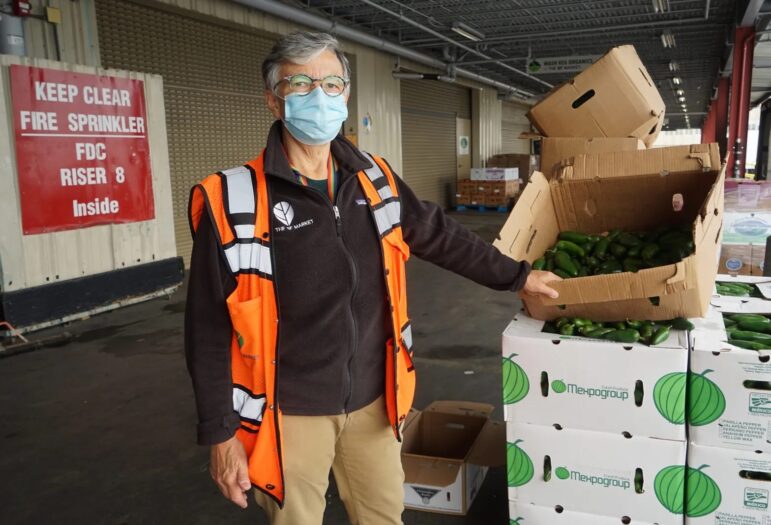
Carolyn Lasar, the market’s food recovery coordinator, said she inspects the quality of products like mushrooms and jalapeno peppers every morning before they are turned over to food pantries.
Still, as the only person at the market who works with food donations, she can only check the quality of food through photos from merchants when she is not on site.
“We have relationships with all of the organizations that we work with, and that means there is a lot of back and forth communication,” Lasar said. “We all know each other and talk on the phone a lot.”
A conundrum from the donation side that Lasar has noticed is that businesses sometimes want to keep their unsold produce as long as they can and may donate food of lesser quality.
“They’re in the business to sell produce, not to donate produce,” Lasar explained. “They’re inclined to hold on to it, thinking they’ll be able to make a little bit of money instead of zero money.”
Lasar said that she hoped SB 1383 could encourage businesses to donate sooner than later so the donations would be of a higher quality.
Processing food from Tier Two businesses, such as restaurants, will be more challenging for food banks, as many provide prepared meals instead of fresh groceries.
“A lot of people don’t realize that if you put food out on a buffet, that food is not donatable anymore,” Weatherby said. “It needs to be food that hasn’t been exposed directly to the general population.”
As SB 1383 regulations won’t affect Tier Two businesses until January 2024, many restaurants and other smaller food suppliers have not started partnerships with food banks.
“Restaurants certainly already engage in donations whenever possible, but it’s too soon for these new regulations to have any significant impact on them,” said Amy Cleary with the Golden Gate Restaurant Association.
Education efforts about the law requirements and food quality are conducted not only by food banks but also at the city or county level.
More businesses are starting to reach out to offer donated food as counties work toward alerting more businesses to the law’s requirements, said Weatherby at Second Harvest.
Olsen with White Pony Express said that local jurisdictions, such as the city of Antioch, have been actively reaching out to food suppliers and helping promote the organization’s food rescue App.
Kelly Gaherty, commercial zero waste assistant coordinator at the San Francisco Department of the Environment, said she and her colleagues started site visits and inspections of Tier One businesses in June. The primary purposes of such in-person visits are to ensure the businesses are aware of the law and ready to meet the requirements.
Gaherty said that she is aware that food recovery organizations are concerned about receiving donation dumping, and considered education at the city and county level an important step.
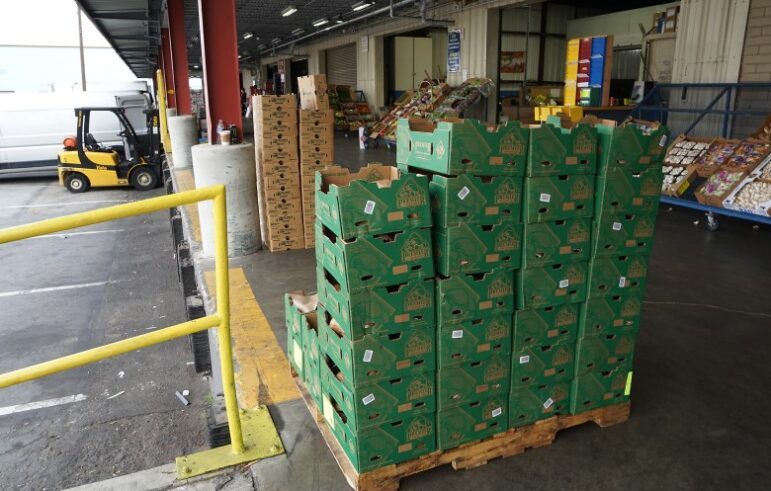
“It’s important for food-generating businesses to understand that, as a client going to a food bank to get food, it would be devastating for them to go all the way there and then receive spoiled food,” Gaherty said.
StopWaste, a public agency tackling waste in Alameda County, created an online guide to safe food handling procedures for different types of food donors to help solve such issues in their county.
“That might look very different for a restaurant compared to a grocery store,” said Cassie Bartholomew, StopWaste’s program manager.
For restaurants that provide prepared food, for instance, the guide suggests that up until pickup or dropoff, hot meals must be held at 135°F or above, cold foods at 41° F or below, and that restaurants should not let food go out of temperature controls for more than 30 minutes during transport.
No matter what, keeping a high standard of food quality is always essential, said Collins from the Food Bank of Contra Costa and Solano.
“The folks in our community that need help with food, they generally don’t work at places that offer sick time,” Collins said. “If they get sick from food, they could lose their job, or they don’t have health insurance to get additional help.”
Financial support from the government is also significant in helping food banks thrive.
In 2019, the San Francisco Department of the Environment received a $500,000 state grant for implementing SB 1383 requirements. The department used the grant to pilot a food recovery program called Kitchen Zero and purchase equipment, such as vans and kitchen equipment, for food recovery services.
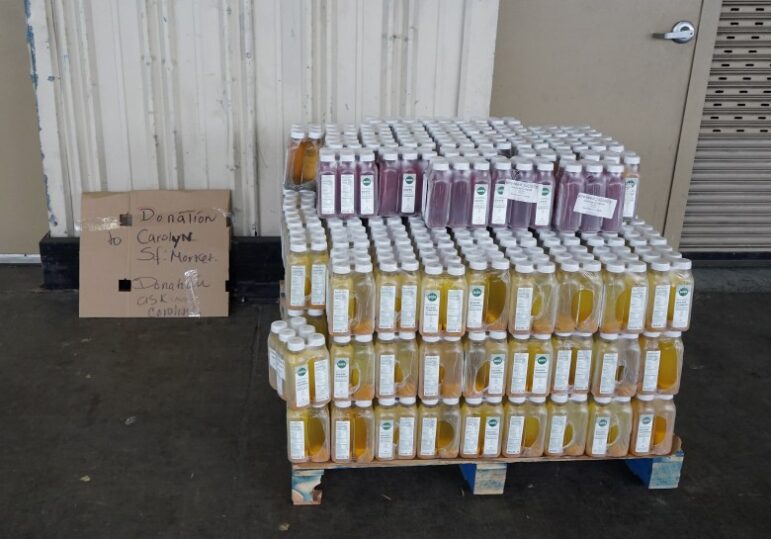
To encourage food rescue programs, the California Department of Resources Recycling and Recovery (CalRecycle) conducted a new competitive grant program. The department awarded a total of $4.75 million to 22 food recovery programs across the state this year.
The funding is supposed to be used for purchasing equipment such as transport vehicles, increasing recovery capacity, conducting education campaigns and constructing larger storage or refrigeration spaces, the department said in a statement.
However, food banks are still calling for more financial support from the state. The department received 61 applications. Forty were considered complete, requesting a total of more than $9 million.
Weatherby from Second Harvest said that her organization was able to build up some capacity, primarily based on private donations. She said that only 5 to 10 percent of the support was from the government.
Hit by higher than expected fuel prices this year, Collins said the Food Bank of Contra Costa and Solano had to maximize every pickup to make it worth the transportation cost and time.
“There are so many expenses that go into moving these donations around,” Collins said.
Despite the challenge, food bank and county officials say the significance of food rescue work can’t be overstated.
Food insecurity issues reached an all-time high during the pandemic, Weatherby said.
Second Harvest served approximately 250,000 people every month before the pandemic, but the number once went up to over 500,000 per month in 2020. Last year, it went back to around 400,000 a month, but was going up again this year because of inflation, high gas prices and many pandemic benefits being stopped.
In this sense, the food donation law has come into force at a vital time, experts say.
“There is such high food insecurity,” Weatherby said. “The more food that we can get into our community, there is no concern about being able to find homes for this food.”
